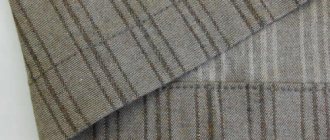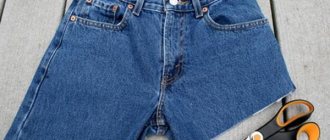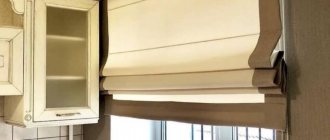The design of a window opening is the most important detail in the design of a room. Beautiful curtains that match the style and color not only perform a protective role, but also create an atmosphere of coziness and comfort. You can sew the curtains yourself or buy a ready-made kit in the store. In any case, you need to be able to hem curtains correctly and beautifully. After all, curtain fabrics are usually sold with a length reserve, and finished products do not always have the appropriate dimensions, so they have to be shortened and hemmed. There are several ways to perform this simple job, which even a novice seamstress can handle.
Preparation of material
A variety of materials are used to make curtains. Thick curtains are made from crepe, jacquard, velvet, velor, thick cotton and linen; thin curtains - made of tulle, nylon, organza. Each fabric has its own characteristics and requires certain processing.
Before you start shortening and hemming, you need to do some preparatory work.
To ensure that the finished curtains do not end up short after the first wash, the fabric is decated. To do this, the fabric is immersed in water for several minutes, then wrung out and hung to dry.
- For processing synthetic materials, the water temperature should not exceed +30°C.
- Cotton and linen can be soaked in hotter water (from +40°C to +60°C).
- Wool, silk and fleecy materials are not decated.
Slightly damp curtains are ironed, setting the setting appropriate for the fabric.
Those materials that are not recommended to be decanted should be hung on a cornice or other crossbar, sprayed with water and allowed to hang for 2-3 days.
Hemming rules
The lengths of finished products may differ for windows located in the same room, and even for different sides of the same opening. Therefore, you should measure all possible values and take the average. This is especially important when the length of the curtains is selected to the floor or exactly under the window. The differences in this case become clearly visible.
The following tips will help you hem curtains and tulle correctly:
- Materials, especially those containing natural fibers, are prone to shrinkage. Therefore, before starting work, it is advisable to wash new curtains and then iron them, following the recommended mode for a certain type of fabric.
- It is advisable to let heavy curtains hang on the curtain for 2-3 days to finalize the length, since the fabric may stretch.
- It is convenient to measure the length on a hanging curtain: secure the selected length with pins on both sides, and then pin marks on the removed ones every 10-15 cm.
- You can measure the distance from the cornice to the selected level using a tape measure, and then calculate the difference between the actual and desired length of the canvas, mark it with pins or draw a marking.
- First you need to iron the fold, this will help to cut the fabric evenly. You can only tear fabric made from natural fibers: calico, chintz, cotton.
The width of the hem of the bottom edge is determined according to the situation. There are no strict recommendations on this matter. Making a large hem is more practical, since you won’t need to trim the curtain and there will be a supply of fabric in case the curtain needs to be lengthened. Wide hems look good decoratively and are suitable for long models of medium density, as well as weighting short curtains.
How to hem curtains by hand and by machine?
When hemming curtains, it is better to use a sewing machine. The work will be done much faster and more accurately than by hand. However, you can do without this device and bend the fabric using a regular needle.
To work you need to prepare:
- sharp needle;
- sewing machine;
- scissors;
- measuring tape;
- ruler;
- chalk;
- pins;
- threads in the color of the material.
The first step is to determine how long the new curtains will be. To do this, use a measuring tape to measure the distance from the end of the hinges on the eaves to the floor or window sill and write down the resulting value.
Then you can follow the following instructions:
- The canvas is laid out on a flat hard surface with the wrong side up. It is better to place a cotton sheet under silk or satin fabric to prevent it from slipping.
- Measure the length of the curtain, making chalk marks in three places: on the sides and in the middle of the canvas. Connect the marks made with a straight line using a ruler. The drawn line is the bottom edge of the curtain.
- Step back from the line by the width of the hem and cut off excess material. To hem curtains made of dense fabrics, you need to leave at least 15 cm. When hemming organza or nylon, it is enough to set aside 5–6 cm.
- The fabric is folded along the bottom edge and ironed to secure it. Then the hem is folded inward by 2-3 cm and stitched with a basting stitch or pinned and ironed again from the inside out.
We recommend: How to remove the smell of paint after painting something in the apartment?
If you decide to sew by hand, you need to take a needle and threads that match the color, get comfortable, since this task will take more than one hour, and start working. You can use a blind stitch or machine stitch. In the first case, neither the seam nor the threads will be visible. But when doing machine stitching by hand, you need to make sure that the stitches are of equal length and the seam runs in a straight line. Careless work will ruin the appearance of the finished product.
Hemming curtains using a sewing machine is, of course, much faster. Moreover, you can use both a regular machine stitch and various decorative stitches. If the hem is high (more than 5 cm), first sew the side part from the bottom edge of the fabric to the end of the hem. Then turn the fabric 90° and sew the hem, departing 2-3 mm from the top edge. At the end, the material is unrolled again and the side part of the hem is sewn.
The threads remaining at the beginning and end of the line must be tied in pairs with a double knot and cut off, leaving tails of 2–3 mm.
Now all that remains is to steam the bottom of the finished product and hang the new curtain on the cornice.
Curtain sewing technology. Education. Calculations. 1. Allowances for processing.
https://tehnolog.umi.ru/risunki_k_rassylke/?p=1 – link to a page with explanatory drawings; tehnolog.umi.ru – link to my website where the page is located.
Let's say we have these numbers:
height from hook to floor – 270cm;
from the bottom of the hook to the top of the curtain – 6cm;
level in relation to the floor – (-1.5 cm);
finished canvas height – 274.5 cm (270 + 6 – 1.5)
L cornice – 190cm;
assembly factor k = 2;
The finished width of the canvas is 380cm (190 x 2).
That is, we know the width and height of the curtain in its finished, sewn form.
When cutting, it is necessary to take into account allowances for processing the side seams, the top of the curtain and hemming the bottom.
So, a prerequisite: the side seams and the hem of the bottom must be filled (the inner hem is equal to the outer).
Why is that?
The curtains hang on the window, which means that during the day they are completely penetrated by light directed from the outside. It becomes clear what is going on inside the processed edge (for example, frayed threads). In addition, if the seam is not filled to the fold, then when ironing the cut hidden inside will be printed (this is especially important for smooth fabrics).
The bottom of the curtain should be quite heavy, this is facilitated by a wide, double (filled) hem (sometimes in combination with a weighting agent).
Side seam allowances (cm):
on the thinnest, transparent fabrics (organza, veil): 0.5 + 0.5 or 1 + 1;
on denser, translucent, gauze-like fabrics: 1 + 1 or 1.5 + 1.5;
Adhesive tape for hemming curtains
A simple and quick way to shorten curtains is to use adhesive tape. This translucent synthetic material, industrially treated with glue, is produced in the form of braid with a width of 5 mm to 5 cm. Gluing occurs by heating the adhesive with a hot iron.
It is clear that this type of fittings is not suitable for working with thin fabrics that cannot tolerate high temperatures. But thick curtains can be folded using adhesive tape. In this case, there will be no seams or needle holes, which usually spoil the appearance of the finished product.
Before starting work, it is better to experiment with an iron and tape on scraps of material and determine the optimal temperature for gluing. It is important not to burn the fabric and at the same time secure the hem firmly.
The shortening process looks like this:
- lay a double hem;
- adhesive tape is placed between two layers of material;
- iron several times with a well-heated iron.
This method has only one drawback: during washing, the glue is gradually washed off and the hem straightens. In this case, you will either have to glue a new tape, or use a special glue to restore the damaged sections of the tape.
Manual binding
Many people are faced with the need to hem things or textiles for the interior very rarely - only when necessary to adjust the length of clothing for themselves or their family. In such cases, it is unlikely that there is a sewing machine in the house. However, it is a mistake to think that without it you cannot cope with the task.
Progress
When you start sewing, you need to measure the correct length. To do this, take into account that the canvas, when it hangs and takes its final shape, may become longer. Shrinkage may occur when washed.
Therefore, before hemming the bottom of the curtain, you need to do the following:
- It is advisable to decate the fabric - perform a wet-heat treatment with an iron in order to immediately ensure shrinkage during the sewing process, and not end up with shortened curtains after the first wash;
- hang the curtain on the cornice with an uncut edge;
- wait until the fabric sags and reaches the correct length;
- pin the intended hem from the bottom and sides with pins; it is better to do this by weight due to possible unevenness of the floor or cornice;
- fix the correct length and remove for further work;
- hem along the entire hem line with a blind seam using one thread to match the curtain.
This method requires minimal sewing skills. It is advisable to first practice on a piece of fabric .
If you have to rip apart unsuccessful attempts, you won’t have to worry that puncture marks will remain. This is especially important for such light fabrics as organza, veil, chiffon. In the instructions in the photo and video, you can learn how to perform blind stitches: their principle is to minimally grab the thread from the front side of the curtain with a needle. Almost imperceptibly, you should try to hook it onto the grain thread, fixing the bartack, and sew it with the hem.
Please note: not all fabrics are suitable for decating. It is better not to wet press velvet, corduroy, natural silk or velor.
Bias trim
You can hem the curtain using bias tape or tape cut from a material in a color contrasting with the main fabric. This finishing will emphasize the exclusivity of the product; the main thing is to choose the appropriate edging material.
To process the edge of the fabric with bias tape, you will need a sewing machine and a special foot, which can be bought in stores with sewing equipment. Having measured the required length of the curtain, cut off the excess material along the line, leaving only 5 mm. The edge of the fabric is inserted inside the bias tape and carefully stitched, trying to place the seam as close to the edge of the tape as possible.
Treat the edge of the curtain with edging material as follows:
- An edging strip is cut out from a contrasting color material. The width of the strip depends on the artistic imagination of the craftswoman, but you should not make the edging too wide, otherwise the product will look tasteless.
- The strip of material is folded in half and ironed to secure the fold.
- The upper and lower edges of the strip are folded inward by 1 cm and ironed again.
- The edge of the curtain is inserted between the two layers of edging so that at least 1 cm of the main fabric is inside. Baste and then sew with a machine seam or zigzag.
We recommend: How to carefully and quickly remove film from plastic windows?
To make the finished product look harmonious, the sides are also trimmed with finishing material.
Methods for processing curtains
To understand how to properly hem curtains, you must first decide on the hemming method. It happens:
- manual;
- mechanical;
- adhesive.
The manual method is the most difficult and time-consuming. But to implement it you only need a thread and a needle. And also - a reserve of time, maximum patience and a willingness to be pricked. Before starting the procedure, you need to at least remember what seams and stitches are. The simplest ones are called:
- estimate;
- machine;
- old;
- overcast;
- in a twist;
- looped;
- secret.
To hem curtains you will need a basting, machine or overcasting machine. There is no need for others.
The manual filing method is the most difficult; it requires patience and skill.
The mechanical method is carried out using a sewing machine. Modern units include several dozen useful functions, including one that allows you to simply and easily make curtains of the desired size and precisely hem the bottom.
If you don’t have a sewing machine in your house, it’s hardly worth buying one just for the curtains alone. Especially when further use of the unit is not expected. A good, high-quality “mechanical seamstress” costs from 5 thousand rubles, but in a salon, curtains can be hemmed for 500 rubles. The difference is obvious.
The mechanical method is suitable for those whose sewing machine does not gather dust in the far corner, but periodically performs its “professional duties.”
If you don’t have a machine in your house, then buying one just for curtains is too expensive.
A quick way to shorten curtains is to buy a special adhesive tape. It comes in different sizes from 1 to 10 centimeters. There are 2 types of such devices:
- the end of the curtain is inserted into a kind of pocket made of ribbon - for this, the ribbon is folded in half along its length;
- The end of the tulle is folded, and an adhesive ribbon is inserted inside the fold.
Which is preferable? It's hard to say. Each type of curtain has its own method. Sadly, adhesive tape does have some disadvantages. Over time it comes off. The drier or humid, colder the room, the faster the ribbon will become unusable. To return the curtain to its previous state, you will have to remove the ribbon completely, buy a new one in the store and “install” it again.
Some housewives claim that you can iron the part that has come unglued again - it will be as good as new. In fact, if the glue has dried, it will be almost impossible to restore the previous abilities.
If the adhesive tape comes off due to use, it should be replaced rather than repaired.
How to hem curtains made of light fabrics?
Thin fabrics – chiffon, organza, nylon, which are popularly called “tulle” – create the impression of weightlessness of the window composition. It seems that there is nothing easier than cutting and hemming such a light curtain. However, this work also poses many difficulties.
The nylon fabric slides, so cutting a straight edge is very difficult. It’s good if the tulle is decorated with a simple symmetrical pattern. In this case, you need to fold the curtain in half, matching the fragments of the pattern, and secure it with pins. If the curtain is wider than 3 m, you can fold the fabric into 4 layers and also secure with pins. After this, measure the required length and cut the fabric with sharp scissors, leaving only 1–1.5 cm for hemming.
A curtain without a specific pattern is more difficult to cut. The length is measured in several places, notches are made with chalk or pins, and only after that the excess material is carefully cut off. This is exactly the case when “measure twice, cut once.”
For hemming, two types of seams are used: “Moscow” and “zigzag”.
"Moscow"
The Moscow seam, or “American” in other words, is used for hemming thin fabrics cut along an oblique line. To get this finish, you need to do the following work:
- bend the edge of the fabric by 5 mm and iron it;
- sew the hem, retreating from the edge of the fabric no more than 3 mm;
- cut off excess fabric as close to the stitching as possible;
- bend the material inward one more time by 5 mm;
- lay a line so that it coincides with the already made seam.
If you carry out this processing of the material correctly and carefully, one machine seam will be visible on the front side, and two lines will be visible on the back side.
Zigzag
The zigzag stitch is found on all modern sewing machines; it is usually used to process internal seams. This stitch is also useful when shortening a light curtain.
- Before starting work, you need to determine the optimal width and length of the stitch so that the hem is smooth, beautiful, and the connection is strong.
- The edge of the fabric is folded 1 cm and the fold is fixed with an iron.
- The fold of the fabric is processed with a zigzag.
- Excess tulle is trimmed with small sharp scissors.
Some craftswomen do not hem nylon curtains, but singe them, trying to seal the edge of the product. This requires some skill, otherwise you can burn the product.
Every housewife with minimal experience in sewing can shorten and hem a thick curtain or thin tulle at home. To do this, you don’t need to have a sewing machine; you can do the job by hand. The main thing is desire and patience.
How to shorten curtains without hemming (features of curtain tape)
If you have no desire at all to shorten the fabric, then the answer to the question of how to shorten tulle without cutting or hemming is the well-known curtain tape. There are several ways to use:
- Method one. Make folds on the curtains, draw a horizontal line (not at the very bottom), pierce the fabric along the folds and thread the threads - this way you can adjust the height of the curtains by simply pulling the string.
- Method two. Sew a narrow curtain tape along the vertical lines to adjust the height.
- Method three. Use special magnets. Gather the curtains at the bottom and secure them between two magnets or on the wall.
- Method four. If you need to make the curtain shorter for a short time, you can simply sew its edge with a large stitch. When you no longer need short curtains, simply remove the thread.
This way you can hem the curtains yourself without resorting to the services of a seamstress. Hemmed curtains look very beautiful in any room and become an interesting decorative element in every room.
How to wash tulle in a washing machine: loading features, temperature and washing modes
Before putting the tulle into the drum, you need to carefully fold it - if you load the fabric in a crumpled form, after washing there will be creases on it. If we are talking about muslin, veil, thin organza with embroidery and other particularly delicate fabrics, it is better to place neatly folded curtains in a special mesh bag for washing - this will not interfere with washing, but will save the fabric.
Tulle is washed in a delicate wash mode - at a temperature of 30° and without spinning . During this type of washing, the drum of the machine rotates more smoothly, and washing occurs with a large amount of water - this minimizes the risk of damage to thin fabric. You can wash tulle curtains on the silk and wool cycles - they are as gentle as possible.
When loading laundry detergent into the machine, be economical . In most cases, housewives add powder or shampoo for washing generously, from the heart. In the case of washing tulle, this can lead to increased foaming, especially if mesh fabric is sent in the wash. Therefore, check the dosage recommended by the manufacturer and, since the fabric is light and the machine operates with an incomplete load, reduce the dose by half.
When washing curtains, it is advisable to use the extra rinse function : detergent residues also lead to premature yellowing of the fabric.
Once dry, the fabric will straighten under its own weight. You can iron tulle only in the most extreme cases, and very carefully - this also leads to yellowing of the fabric.
Advice from experienced craftswomen
To ensure that the finished curtain drapes softly and looks beautiful on the window opening, there are some sewing features. Depending on the density and type of material, it is worth considering secrets .
- Curtain fabric needs pre-treatment - decating.
- Fabrics that require careful handling and cannot withstand too hot ironing cannot always be treated with adhesive tape. Such curtains are folded with a double hem.
- Organza and tulle are often sold with a weight at the bottom - a decorative cord that is sewn in at the factory. Then you need to shorten the tulle from above, adjusting it with curtain tape.
- It is not recommended to iron some types of fabrics with steam: velvety, velor, plush. Creases and shine may appear on the canvas. It is better to hem such fabrics by hand.
- Thick curtains with heavy fabric will look easier with one hem. The bottom of rigid fabrics, folded 2 times, will complicate vertical drapery. This will not have the best effect on the overall appearance.
- Before shortening the curtains without cutting off the excess edge, you should try to first roll them up by 7-10 centimeters and pin them with needles, then hang them on the curtain rod and look at them from afar. If the curtain looks normal, you shouldn't cut off what can be hidden in the hem. During the next wash, the curtain may shrink significantly, and then there will be a chance to loosen the edge a little.
- When using duct tape, you may need to lay it in two rows if the fabric is rough.
- After washing, the tape may lose its adhesive properties in some places. Then you will have to glue it again, or it is recommended to use two methods at once: additionally lay hidden stitches on top of the tape.
When hemming curtains, the main thing is to take into account the recommendations from tailors and not make a mistake with the length of the curtains. The appearance depends on this: a short curtain will create a feeling of incompleteness, and a curtain that is too long will create creases and will not give the expected elegance to flowing draperies.
General recommendations for hemming curtains
The need to shorten the curtains can arise at any time: for example, if you decide to hang long curtains from the bedroom in the kitchen, or after moving to a new place it turns out that the fabric is bunched up on the floor. You can shorten the fabric in 2 ways: cut or bend.
Not everyone likes long curtains
Important! Before cutting off an extra piece, you should think carefully about whether you will regret it.
Before you start, you should familiarize yourself with some general rules:
Before work, the fabric needs to be stretched out as much as possible. Curtains that “sweep” the floor look ugly.
You might be interested in How to make your own beautiful toy bear from felt and other fabric
The braid around the edge looks elegant and can liven up curtains
Measurements
Before you start measuring, it is important to let the fabric stretch and sag - only then can you remove the fabric and start measuring. You can measure fabric only on a smooth surface, for example, on a clean floor. If it wrinkles a lot, you should iron it in advance.
Important! Sometimes the length of the curtains is much longer than necessary (for example, the length of the fabric is 3 meters with a room height of 2.5). In this case, it is worth removing exactly the extra piece, then starting measuring.
It is believed that the length of the curtains should be 5-10 cm less than the height from the ceiling to the cornice, otherwise the fabric will reach the floor. When hemming, add 8-14 cm to the resulting number, depending on the fabric and the desired shape. For example, if you need to tuck the material twice, you should leave more space, if only once, or use less braid.
Measurements must be fairly accurate
It is also worth considering the desired shape of the curtains and location: for example, in the kitchen, many people hang curtains up to the window sill, in the living room - up to the floor.
Trimming
You should only cut fabric if there is a lot of it. If the curtains are 10-20 cm longer than required, it is better to fold them and hem them, then, if necessary, the length can be returned.
Cut with large, sharp scissors without lifting the fabric. To ensure an even cut, you should draw a line in advance, cut as much material as possible at a time and do not lift the fabric by hand.
The material should be cut off if there is too much excess fabric
Hemming light fabrics
If you need to finish the edge of a dress made of thin fabric or tulle, use adhesive web to match the product.
You can do the job by following simple instructions:
- Place the product on a flat surface so that the edge is within your reach.
- Take chalk or soap and draw a line along which you want to glue. Leave a small margin at the bottom of the hem, about half a centimeter.
- Carefully place the adhesive strip along the mark. If the tape is on paper, you need to put the tape so that the paper layer is on top. If you don't have one, use a piece of parchment and place it on the web.
- Run a heated iron over the paper to melt the glue.
- Remove the paper layer.
- Fold as needed. You can secure it in some places with pins so that the fabric does not move out.
- Iron thoroughly.
Advice! If the heating temperature is too high for this type of fabric, use a layer of gauze or cloth. Iron the hem through it.
It is important to consider that the adhesive material seals the fabric. Consider the possibility of its use before starting work.
Using web tape
The sticky properties of “web tape” (also called sewing tape) allow you to do without thread and needle at all. The advantage here is accessibility and ease of use. All you need is:
- accurately measure and tuck the material by 1-3 cm;
- iron the bend;
- lay the tape inside to secure the hem;
- Glue with an iron using damp gauze (look at the condition of the fabric).
The difficulty lies in the fact that fabric that requires careful handling cannot be ironed at high temperatures, connecting two edges. The tape just won't stick. Thin synthetic curtains melt from a hot iron. You need to carefully increase the degree of heat, after experimenting on scraps. Otherwise, you will have to resort to the first method or machine stitching.
Attention: do not go over the same place with the iron several times. The opposite effect is possible and the tape will come off.
Processing curtains, tulle or organza with a zigzag stitch
When processing the cut edge of a curtain with a zigzag stitch, bend the edge of the tulle or organza by at least 1 cm.
Iron the hem of the curtain; this way it will be easier for you to sew a zigzag stitch.
Before hemming curtains in this way, you need to adjust the thread tension of the sewing machine, the length and width of the stitch. Take a piece of organza or tulle and make a prototype.
This kind of neat and beautiful scar should be obtained by processing the cut edge of tulle or organza in this way.
Now take sharp, thin-bladed scissors (you can use nail scissors) and carefully cut off the excess tulle so as not to damage the main fabric of the curtain.
This is what a curtain processed with a zigzag will look like on the wrong side of organza.
The right side of the folded edge of the chiffon is finished with a zigzag.
Video on how to hem a dress or skirt made of chiffon. The video is in English, but understandable without words; you can turn on subtitles in the language you need.











